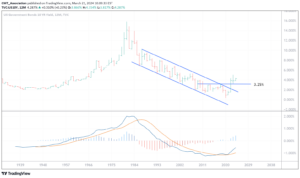AT A GLANCE
- With the emergence of interest rate derivatives like futures and options, the U.S. economy is better able to manage risks associated with interest rate changes than it was in the past
- In a new normal for inflation, cash is likely to be a long-term, income-producing alternative to manage risk in a diversified portfolio
U.S. headline CPI inflation has had an impressive surge and an equally impressive reversal. Are Americans heading back to the good old days of persistent low inflation? Unpacking the trends in CPI and their causes suggests not, with important implications for all of us in the real economy.
The rapid decline in headline inflation is occurring primarily due to the causes of the price surge being removed. Or, as Will Rogers famously observed: “if you want to get out of a hole, stop digging”. When the COVID pandemic hit, 22 million U.S. workers lost their jobs. Then U.S. policymakers provided $5 trillion of government spending to cushion the blow, which was financed by $5 trillion of Federal Reserve purchases of Treasuries and mortgages.
The massive spending surge on goods triggered supply chain challenges, making the inflation surge all the worse. As the inflation problem was recognized and the pandemic faded away, no further government stimulus was provided, the Fed started to raise rates and shrink its balance sheet, and supply chain disruptions were resolved. In short order, with the causes in reverse, headline inflation began to recede.
Core inflation has been a different story because the shelter component of the price index is rising at an 8% rate and receives about 40% of the weight in the index. Part of the problem is simply in the way shelter prices are calculated in terms of homeowner equivalent rent. It is an arcane and lagged calculation based on a formula of how much a homeowner would charge to rent the house. In the last few months, we note that rental housing inflation is running at about 0.5% per month or a 6% annual rate — still high but starting to moderate.
Hedging Makes All the Difference
There is also the debate concerning why higher interest rates have not caused a recession or unemployment to materially rise. The link between rates, jobs, and inflation has dramatically changed over the decades. Back in the 1950s and 1960s, the U.S. economy was driven by manufacturing and housing. Many financial institutions had at their core a business plan of borrowing short-term money from depositors or savers and lending longer-term for houses or automobiles. The interest-rate risk embedded in this business model was huge and not easily hedged, so when rates went up, the economy went down.
Fast-forward to today’s service economy. Home mortgages are originated and then sold to institutions or funds willing to hold them. Interest-rate risk is efficiently managed through interest rate derivatives such as swaps, futures, and options, which did not exist in the 1950s and even into the 1970s.
Taking interest-rate risk is now a choice, not a business model. And the result is that the U.S. economy is much less-sensitive to rate changes. Yes, rate hikes matter, but now more for the value of stocks, bonds, and houses than for the functioning of a real economy with the tools to manage the risks. And so, the widely forecasted recession based on rising rates has not happened yet.
Eventually, maybe some unexpected disaster may tilt the U.S. economy into recession, but still popular, outdated economic models vastly underestimate the resilience and robustness of the economy.
The New Normal
There is also the path of future inflation to consider. To gain a perspective one needs to appreciate why inflation was so subdued in the 28 years before the pandemic, which had little to do with interest rate policy. Globalization had reduced supply chain costs. Technology and the internet had empowered consumers to be comparison shoppers, shifting pricing power away from businesses. Demographic trends supported an expanding labor force, helping to keep inflation low.
Unfortunately, the forces that brought subdued inflation are no longer available to help. Supply chains are being reconfigured for resiliency, at a cost to consumers. New technologies, such as artificial intelligence, are more likely to be labor-saving and help protect profit margins rather than lead to lower prices. Plus, the low U.S. birth rate and retiring baby boomers now represent demographic headwinds that point to a pattern of sustained labor market tightness.
Given the progress on headline inflation, the Fed may be at or close to peak rates.
Nevertheless, as the Fed has guided, rates may have to stay higher longer than the current consensus expectations embedded in federal funds futures given the persistence of inflation above their 2% target. Market participants who haven’t priced in a potential new normal for inflation need to revisit their models. The implications are that an allocation to cash is likely to be a long-term, dependable income-producing alternative to manage risk in a diversified portfolio.
—
Originally Posted July 19, 2023 – The Link Between Rates, Jobs and Inflation has Changed
Disclosure: Interactive Brokers
Information posted on IBKR Campus that is provided by third-parties does NOT constitute a recommendation that you should contract for the services of that third party. Third-party participants who contribute to IBKR Campus are independent of Interactive Brokers and Interactive Brokers does not make any representations or warranties concerning the services offered, their past or future performance, or the accuracy of the information provided by the third party. Past performance is no guarantee of future results.
This material is from CME Group and is being posted with its permission. The views expressed in this material are solely those of the author and/or CME Group and Interactive Brokers is not endorsing or recommending any investment or trading discussed in the material. This material is not and should not be construed as an offer to buy or sell any security. It should not be construed as research or investment advice or a recommendation to buy, sell or hold any security or commodity. This material does not and is not intended to take into account the particular financial conditions, investment objectives or requirements of individual customers. Before acting on this material, you should consider whether it is suitable for your particular circumstances and, as necessary, seek professional advice.


































Join The Conversation
If you have a general question, it may already be covered in our FAQs. If you have an account-specific question or concern, please reach out to Client Services.